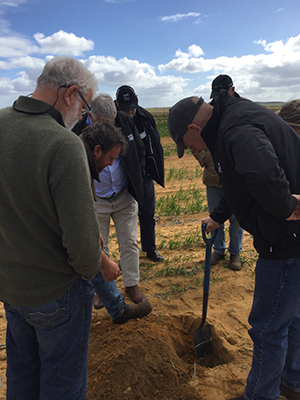Key representatives from the Grains Research and Development Corporation (GRDC) have recently travelled extensively through the Western Australian grainbelt – to consult with as many growers as possible.

Two GRDC western region spring tours have been conducted – one through the central and northern grainbelt from August 15 to 17, and the other in the Esperance port zone from September 11 to 14.
GRDC personnel taking part included Western Regional Panel members, board members and western and national staff.
Areas visited in the central and northern tour included Dandaragan, Marchagee, Perenjori, Latham, Dalwallinu, Kalannie and Ballidu.
The Esperance port zone tour travelled through Esperance, Beaumont, Lake King, Ravensthorpe, Dunn Rock, West River and Munglinup.
“The spring tours visit different areas of WA’s cropping areas each year and are all about the GRDC interacting with growers and understanding their grain production issues, and having a general discussion about the GRDC’s role,” GRDC Western Regional Panel chairman Peter Roberts said.
“The GRDC Western Regional Panel and staff will use information from the spring tours to help refine the GRDC’s research, development and extension (RD&E) investment portfolio at a regional and national level.
“I also expect that issues identified – including information relating to dry seasonal conditions and a variable climate – will help shape the content of presentations at next year’s GRDC Update events in WA.”
Mr Roberts said growers visited were facing vastly different seasonal conditions, with parts of the central and northern grainbelt having the lowest 10 per cent of rainfall totals on record, and most growers in the Esperance port zone experiencing a more favourable season, although some had experienced severe erosion from flooding.
He said that despite the variation in rainfall, soil constraints issues were commonly raised by growers as a high priority issue across the State.
“Among the challenges for many WA growers is the sometimes huge level of differentiation of soil types within their paddocks,” he said.
“This means some soil amelioration methods may not be appropriate for them, and there needs to be a better understanding of where these amelioration methods fit in each sub-zone in a paddock.
“Ultimately, the common aim of growers and the GRDC is to increase the water holding capacity of soils to help meet the challenges of an increasingly variable climate.”

Mr Roberts said a major GRDC investment – the Soil Constraints suite of projects – started in WA in recent years, addressing the key issues of soil acidity, non-wetting soils, soil compaction and sub-soil constraints.
“New western region investments addressing gravel soils and soil sodicity are also in the pipeline,” he said.
Mr Roberts said one of the other issues commonly raised on both tours was problems with Internet and phone connectivity.
“This connectivity issue directly impacts on challenges the GRDC faces in extending information to grain growers,” he said.
“However, the creation of a number of new WA-based roles (including grower relations managers), as part of the recent change in the GRDC’s staff structure, will go some way to improving the extension of information to growers in the western region.”
Mr Roberts said growers had also identified a need to capitalise on opportunities relating to climate variation.
“They want to adopt farming practices in line with rainfall shifting – in many cases – earlier in the season,” he said.
“One key question is: ‘How do we capitalise on summer rain?’.
“In drier parts of the State, this question is about saving that moisture, while in some southern cropping areas it’s about utilising this summer moisture in a way that will form a new part of their farming system – for example, through the introduction of new crops or pastures.”
Mr Roberts said growers recognised the importance of the GRDC’s National Variety Trials investment – a national program of comparative crop variety testing with standardised trial management, data generation, collection and dissemination.
“Another issue, particularly in the northern and eastern cropping areas, is growers wanting to know the economics of lime application and incorporation on lower yielding country,” Mr Roberts said.
“Other issues broadly raised include emerging summer weeds; a need for legume varieties and agronomy packages better adapted to their environment and farming systems; and frost.”
The GRDC’s purpose is to invest in RD&E to create enduring profitability for Australian growers. It invests in projects and partnerships that drive profitability, productivity within Australia’s grains industry.


